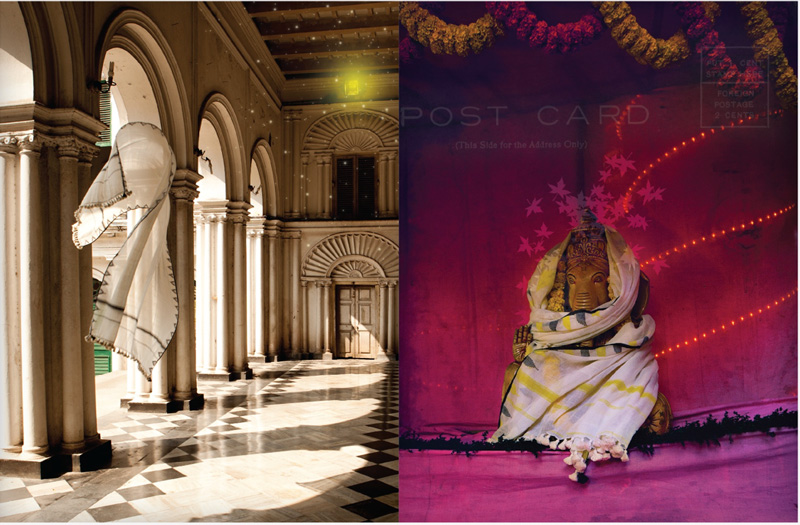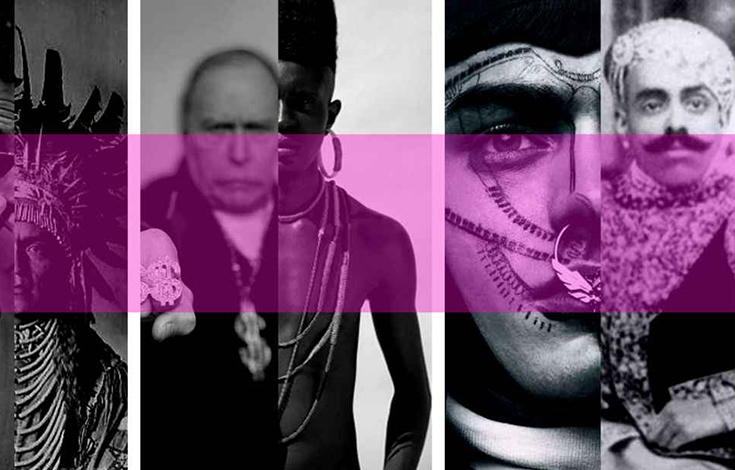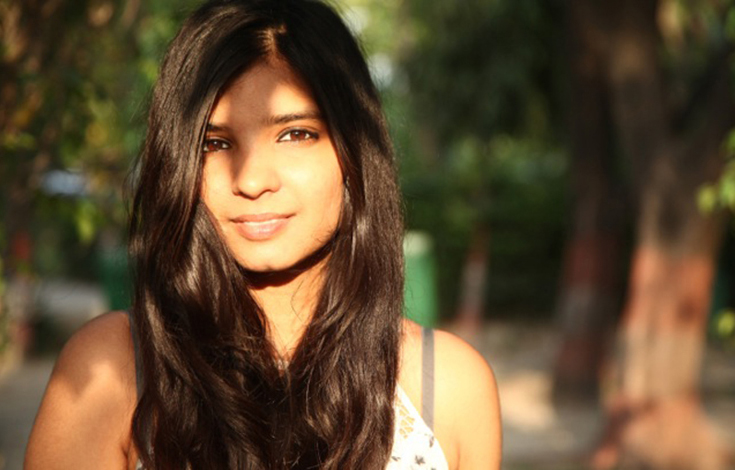The beginning
I stumbled into textiles in 2009 through an opportunity with a friend from my old city, New York. She had started The Nomadic Thread Society to work on her longtime passion for fair trade and handloom textiles. At that point I was in the conceptual phase of a new venture; facilitating and holding design conferences in India. It was a big dream and on paper it seemed like something that I would be most happy with. After much deliberation I decided to ‘go with the flow’ of opportunities and started working as a buyer for her part-time – still a little hesitant. That was my first initiation into the world of handloom; I started going to all the Government emporiums in Delhi, Kolkata and Chennai, attending craft fairs like Dastkar, random Government exhibits, Craft Council exhibits and understanding textiles and yarns from different parts of the country.
 Above: source | Fashion TV ‘Out of Africa’
Above: source | Fashion TV ‘Out of Africa’
My first lesson in handloom was from my ‘Bengali Dadi’ (grandmother), a relative of our family. I got an opportunity to visit the Bengal looms with her, as she had started her own brand of artisanal sarees from Bengal and Benaras many years ago. To get a deeper understanding of the technical process, I did a three week program in Chennai Weaver’s Centre on the basics of weaving – facilitated by Ms. Kalyani Pramod, a force in the weaving movement of the South. I saw the warping process, helped set up my own table loom and wove seven inches of fabric myself.
One thing was very clear after: we all think we know that handloom is labour intensive, but you don’t know the extent of the work until you actually do it.
Business was picking up for my friend in NYC and I was getting more confident about my idea of what would sell. During this time, one of the Bengal weavers agreed to start making custom designs in very small lots – this was a big development. Riding on this opening, I started my own brand in 2010 under the name of my then four-year-old recycling project called ‘Let’s’. We started under this name mostly because it was available and running.

I have no formal training in either fashion or textiles. I did go to an art school for post graduation and got an experimental art degree in tech + art. The most important takeaway was the experience of working with multidisciplinary teams. You understand that things are done when you accept that every person has their own expertise and that we all need to work together to finish a project.
A year later, the name ‘Let’s’ seemed aggressive for our kind of textiles; it wasn’t conjuring the feeling that we wanted to create. We wanted something soft, luxurious, unapologetic and endless — like a river. We decided to change the name to AISH.
Every time I touch a fabric it’s like traveling to a different space. If it’s a new feel for my hand, then it’s like discovering another country. I love working with textiles – not cane, not wood… it’s about textiles. This one acceptance has changed my basic everyday feeling. It’s a feeling akin to finding ‘the one’.
Challenges of a niche positioning
When we decided to launch, my mind wasn’t just brimming with product ideas but I was also concerned with the feeling that I wanted our products to invoke. Of being on a vacation that doesn’t have much of an agenda, invoking freedom, vitality, a sense of abundance and endlessness of time. The fabric should feel so good that without really trying we immerse the user completely into its world of soft, fine luxury – ‘The Aish Life’. After the saree, the long dupatta scarf is the closest we get to uninterrupted, unstitched fabric that is easy to carry and wear. It’s also the modern day answer to having and wearing an heirloom textile.
Above: photography | Sebastian Kim source | Vogue Australia
A limited range is both a challenge and an advantage. It’s a challenge because I’m tempted to do many things, but there’s a large benefit to staying very focused. In a mature market like the US, it’s hard to break through in very traditional categories. We started too wide in the beginning, then went small, and then last year we tried going wide again with ready-to-wear, which completely backfired. We had a hard time convincing American buyers that these new categories from us were something they could take a chance on, especially when they were already buying tried and trusted brands in those categories. Maybe it was too early for us, but it brought us back to our roots.
We’re a small brand with limited resources, and we spread ourselves too thin, becoming average at a lot of things instead of sharp at one thing – leisurewear, which is where we want to be. You have to remember that you can build your brand story and recall without diluting yourself.
But, I also love the fact that everybody wants a piece of the pie. It means that many more people are going to be buying scarves and so many new people will be converted into scarf lovers. There is no fun working in an environment without challenge, I am grateful for the competition and what it teaches me – never take it for granted and don’t be laid back. I want to concentrate on excellent quality, keeping the creative taps running and taking my risks. People will come.
Craftsmanship
We work with north Bengal weavers that specialize in muslin, jamdani and khadi – this constitutes 70% of our product line. We also source indigenous fabric from many communities: mirror work from Kutch, single ikat from Pochampally, Sambalpuri ikat from Orissa, pashmina from Kashmir, lungis from Tamil Nadu.
The best part about working with a craft is the unexpected imperfections, like the slubs (small sections of hand spun yarn that open up a little after being woven, and give the fabric its own unique texture and look) that can never be attained by careful planning and designing.
The worst part is that so many weavers and middlemen try to hide their sloppiness, lack of precision and general disregard for quality, behind the biggest disclaimer of all – “it is the nature of handloom.”

Transparency
I don’t want to say it’s the core for us, but it’s a very important part of how we’re communicating our brand. In some way or another there is an artisanal element in our clothing whether it’s dyeing, washing or handweaving. It was hard to brand ‘Made in India’ when we first got into the international market. People didn’t look at ‘Made in India’ items as luxury items. It was mostly the American and European designers who came to India who were successful in the American and European markets. Like Christina Kim of Dosa or Matta NY.
Very few Indians can establish a successful brand in India. I think it’s hard not necessarily because of discrimination, but because you’re trying to talk to a culture you’re not from. That’s the bigger struggle than ‘Made in India’ – getting people to believe the ‘Made in India’ label from a non-American or Non-European. Injiri and Pero are doing it well. But otherwise, there are very few people. The indigenous, nomadic, travel inspired, gypsy phase is done.
People
As I grow older I am figuring out that there are many things that I learnt from my dad. He is a technical man with a deep desire to solve problems and get to the bottom of something. He was a pioneer in manufacturing. He not only has an amazing sense of design and colour but also had a burning need to bring new technology to the manufacturing industry. He started his career with export of high quality men’s shirts to countries like Germany and the UK by partnering with big brands like Siedensticker, gradually moving on to become the sole manufacturer of dress shirts for 30 years for a leading menswear brand in India.
Growing up, I have seen him to be very particular about small details like the pressing and fusing of a collar, making sure there are no creases, and that it’s not too stiff or too soft and that it sits just right. This obsession with detail is what I have somehow learnt either by inheritance or observation. I don’t care if other people can see it, I like our products to be made to the best of my knowledge. I like the tiles in the bathroom to be laid well. I like the finishing of corners to be neat and strong. I don’t like design elements that have no purpose. Good design like good writing is precise and I am more a proponent of utility than “useless-ism.”

Travel is my closest companion, my confidante and my teacher – please don’t confuse this with vacation. Travel is different, it’s uncomfortable and unexpected. I have bloomed on this base of constant travel and exploration. I thrive on movement. When I haven’t left home for a month or so, and life starts getting routine, I remind myself to not get too comfortable, that all good things lie outside my comfort zone. I travel often and sometimes alone – that’s how I sharpen myself, the old falls away and I feel new and pointy again. There is nothing else more simple and true for me.
Domestic and international markets
Since day one, I was clear that my focus would be on the international market. This was not based on market research, but my knowledge that retail in India wasn’t organised. It still isn’t but it’s better than it was 6 years ago. At the outset, we were a small, young and inexperienced brand, and trying to break into the international market is very hard to do. Coming from India, international buyers wanted to box me into a manufacturer role. Therefore, I decided to keep my visual communication pretty strong and chose to spend all of my resources on that.
The first visual campaign was a leap of faith, and our first intro to the international market didn’t go well. We started out trying to do too much and presented too much. After that experience, we did a brutal editing round and came down to a very basic offering of leisurewear that was easy to understand, had an impact and wasn’t getting lost. A year later, I saw the change – so many retailers became interested. At that time in America, our product wasn’t in the market yet. I was able to carve out a niche space. I think that helps me stand apart now. The market has matured and there is a lot more competition, but the retailers and consumers remember us and have stayed with us.
I love the fact that everybody wants a piece of the pie. It means that many more people are going to be buying scarves and so many new people will be converted into scarf lovers. There is no fun working in an environment without challenge, I am grateful for the competition and what it teaches me – never take it for granted and don’t get laid back. I want to concentrate on excellent quality, keeping the creative taps running and taking my risks. People will come.
Digital references
Design Observer Nowness Trendland Brain Pickings Vice Style.com
Work history
AISH Life: Creative Director and Owner, 2009 – present
Let’s – A Recycling Design Project: Owner, Chennai/Kolkata, 2007 – 2008
Siddhartha Apparels: Head of Design, Chennai, 2005
Mirabai Films (The Namesake): Intern, New York, 2005
The Renegade Marketing Group, Project Manager, New York, 2001 – 2003
Above: Aish Spring/Summer 2015










i would love to sport your scarves. I interface with about eighty women a month in my social life, many, many of them scarf wearers. Where are they available in the US? Love hearing that Nupur, whom I had the pleasure to travel with on Semester at sea still travels. Hans Christian Andersen said, “To travel is to live”
Great article. Very inspiring for enterprenuers working with crafts and design.
Wow, this is the other side of you Nupur, extremely well written and so much to know about you and your thoughts , all the best and look forward to seeing Aish world over .. it is rightly said, you invoke my heart and it opens up to so many hidden thoughts..
LOVE THIS. Beautiful Nupur.
very well written nupur… this is truely u